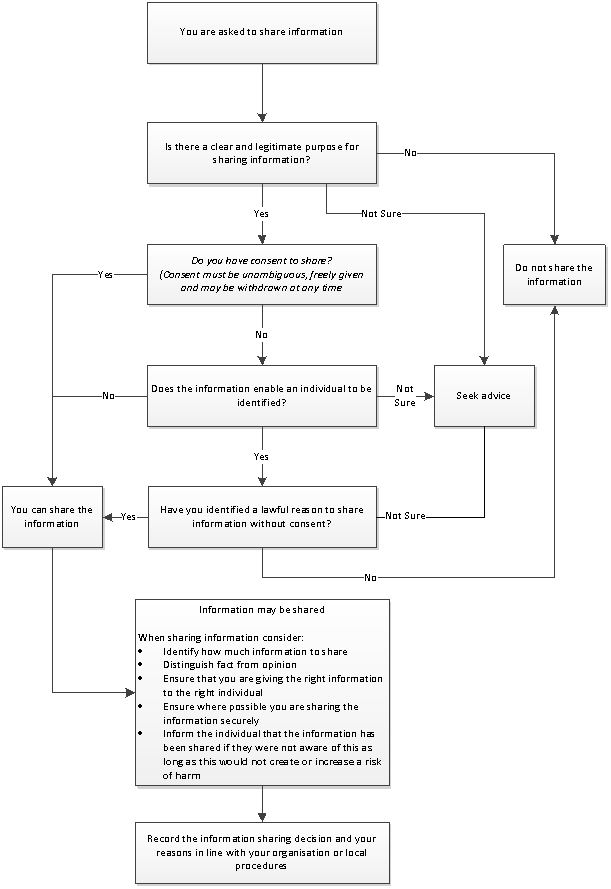Information Sharing
Why is information sharing important to safeguarding?
Information sharing is vital to safeguarding and promoting the welfare of children, and young people. and adults. All information sharing must be in accordance with the Data Protection Act 2018 (DPA). Additionally, Working Together to Safeguard Children (2023) continues to outline specific guidance on information sharing to ensure the safety and welfare of children, with the guidance continuing to emphasise the necessity of multi-agency working, and makes clear the joint functions of all delegated safeguarding partners.
Effective and appropriate information sharing between practitioners, local organizations, and agencies is crucial for early identification of a child’s needs, assessment, and service provision to ensure their safety as well as a better understanding of any contextual factors, as no single practitioner can have a complete picture of a child’s circumstances.
A key factor identified in many Safeguarding Practice Reviews (SPR) and Safeguarding Adults Reviews (SARs) has been a failure by practitioners to record information, to share it, to understand its significance and then take appropriate action.
What are the key things I need to consider when sharing information?
Fears about sharing information cannot be allowed to stand in the way of the need to safeguard children, young people or adults at risk of abuse or neglect. No practitioner should assume that someone else will pass on information which may keep a child, or young person or adult at risk safe.
Practitioners should use their professional judgement when making decisions on what information to share and when. They should follow their organisation’s procedures, any information sharing agreements in place with their organisation and their partners and consult with their legal department/seek legal advice if in doubt. The most important consideration is whether sharing information is likely to safeguard and protect a child, young person or adult at risk.
For adults at risk you should consider:
- Has the person consented to the sharing of information?
- Is it in the adult’s vital interests to prevent serious harm or distress or life-threatening situations?
- Is it in the public interest e.g., there is also a risk to others?
- Whether the adult has care and support needs
- Is the adult at risk subject to coercion or undue influence, to extent that they are unable to give consent?
- Does the adult lack the mental capacity to consent to a referral to Adult Social Care and it is in the adult’s best interests?
HM Government provides advice for practitioners regarding information sharing for the purpose of safeguarding children. Although intended for safeguarding children and young people, the principles of the guidance also apply to adults.
It identifies the principles of information sharing as:
▪ Necessary and proportionate – Consider how much information is needed to be released. Don’t share more data than is necessary to be of use is a key element of the DPA and consideration should be given to the impact of disclosing information about a person to any third parties. It must also be proportionate to the need and level of risk.
▪ Relevant – Only information that is relevant should be shared with those who need to know. This allows others to do their job effectively and make informed decisions.
▪ Adequate – Information should be adequate and proportionate for its purpose it is disclosed. Information should be of the right quality to ensure that it can be understood and relied upon.
▪ Accurate – Information should be accurate and up to date and should clearly distinguish between fact and opinion. If the information is historical then this should be explained.
▪ Timely – Information should be shared in a timely to reduce the risk of missed opportunities to offer support and protection to a child. or adult. Timeliness is key in emergency situations, and it may not be appropriate to seek consent for information sharing if it could cause delays and therefore place a person at increased risk of harm. Practitioners should ensure that sufficient information is shared, as well as consider the urgency with which to share it.
- Secure – Information should be shared in an appropriate, secure way. Practitioners must always follow their organisation’s policy on security for handling personal information.
- Record – Information sharing decisions should be recorded, whether the decision is taken to share. If the decision is to share, reasons should be cited including what information has been shared and with whom, in line with organisational procedures. If the decision is not to share, it is good practice to record the reasons for this decision and discuss them with the requester. Information should also be kept in line with the organisations retention policy and not for longer than is necessary.
Information must be shared appropriately – Be open and honest with the individual about why, what, when and with whom the information will be shared unless it is inappropriate to do so. Seek advice from other practitioners or speak to a Manager or seek legal advice if you are in any doubt about disclosing the information.
The Data Protection Act (2018) and Human Rights Act (1998), are not barriers to prevent information sharing but provide a framework to ensure information is shared appropriately. Where possible, unless it is unsafe or inappropriate to do so, information should be shared with consent; however, information can be shared without consent if in your judgement there is a lawful basis to do so, as outlined above.
When and How to Share Information

For more information please see the HM Government ‘Information Sharing: Advice for practitioners providing safeguarding services to children, young people, parents and carers (July 2018)’
Related Documents.
- Information Sharing: Advice for practitioners providing safeguarding services to children, young people, parents and carers Updated May 2024.
- National Guidance in Information Sharing. Serious Violence Duty. Updated October 2023.
- Data Protection Act 2018.
- Working Together to Safeguard Children (2023). Chapter 1, pg 18. Common Myths – pg 21. Chapters 2 & 4.
Updated: 25 September 2024




 View all our news
View all our news